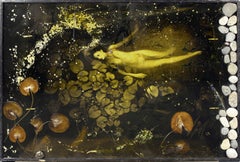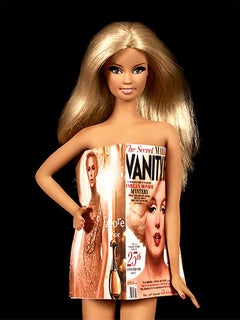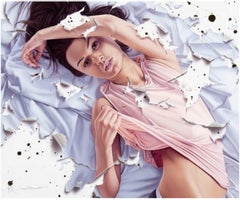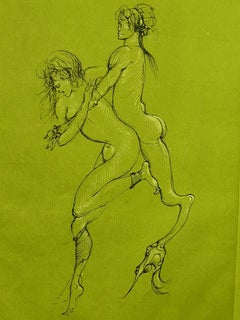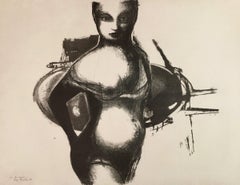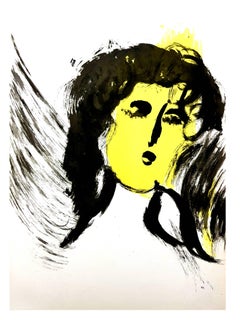Face Nude Prints
to
134
277
162
192
50
39
Overall Width
to
Overall Height
to
248
152
76
51
36
15
9
8
5
4
1
1
41
25
22
18
15
10
19
552
146
8
19
46
51
15
38
69
126
79
35
7
498
210
8
1,837
1,144
863
727
455
425
401
382
261
83
72
62
60
55
48
46
44
44
36
34
334
201
88
38
32
83
251
359
328
Art Subject: Face
"Coda" archival print, oil paint and mixed media work encased in resin
Located in Boca Raton, FL
"Coda" by artist Raphael Mazzucco. Archival print of nude woman floating in water with oil paint and mixed media encased in beautifully aged resin in...
Category
2010s Contemporary Figurative Prints
Materials
Resin, Mixed Media, Oil, Color
VANITY FAIR
Located in Aventura, FL
Cécile Plaisance uses a technique of lenticular developing, super imposing images which creates an image of Barbie from a functional role to undressed. From Lens Series. Edition of...
Category
2010s Contemporary Nude Prints
Materials
Lenticular
$12,000 Sale Price
20% Off
3 Days (AP 6/6)
Located in Dallas, TX
Archival Pigment Print On 300 gsm Somerset Paper
With 2 layer screen print
Edition of 50
Signed And Numbered By The Artist
59.5 X 49.5 Cm
2019
Comes with Certificate Of Authent...
Category
21st Century and Contemporary Street Art Portrait Prints
Materials
Archival Pigment
$528 Sale Price
20% Off
Leonor Fini - Satyr - Original Handsigned Lithograph
By Leonor Fini
Located in Collonge Bellerive, Geneve, CH
Leonor Fini - Satyr - Original Handsigned Lithograph
Circa 1982
On colored paper
Handsigned and Numbered
Edition: 275
Dimensions: 69 x 52.5 cm
Category
1980s Modern Nude Prints
Materials
Lithograph
Girl, 4 from Europäische Graphik VI, Black and White Lithograph Print, 1968-9
By Reg Butler
Located in Kingsclere, GB
Girl, 4 from Europäische Graphik VI, Lithograph on Arches Paper (Unframed) Painting by Reg Butler, 1968-9
Additional information:
Medium: Lithograph on Arches paper (unframed)
54 x ...
Category
21st Century and Contemporary Nude Prints
Materials
Lithograph
Marc Chagall - Woman Angel - Original Lithograph
By Marc Chagall
Located in Collonge Bellerive, Geneve, CH
Marc Chagall, Original Lithograph depicting an instant of the Bible.
Technique: Original lithograph in colours
Year: 1956
Sizes: 35,5 x 26 cm / 14" x 10.2" (sheet)
Published by: Édit...
Category
1950s Modern Figurative Prints
Materials
Lithograph
"Lovesick" Black & White Photography 45" x 30" in Edition 1/7 by Larsen Sotelo
Located in Culver City, CA
"Lovesick" Black & White Photography 45" x 30" in Edition 1/7 by Larsen Sotelo
Not framed. Ships in a tube
Comes with COA
Available sizes:
Edition of 24: 27" x 18" inch
Edition ...
Category
21st Century and Contemporary Modern Nude Prints
Materials
Archival Ink, Rag Paper, Giclée
"Blue Kate Moss Triplet" Photography 28" × 26" in Edition of 25 by Kate Garner
By Kate Garner
Located in Culver City, CA
"Blue Kate Moss Triplet" Photography 28" × 26" in Edition of 25 by Kate Garner
Signed & dated.
Comes with COA
Archival Hahnemuhle art paper
Not framed. Ships in a tube.
Garn...
Category
21st Century and Contemporary Contemporary Nude Prints
Materials
Archival Paper
André Derain - Ovid's Heroides - Original Etching
By André Derain
Located in Collonge Bellerive, Geneve, CH
André Derain - Ovid's Heroides
Original Etching
Edition of 134
Dimensions: 32 x 25 cm
Ovide [Marcel Prevost], Héroïdes, Paris, Société des Cent-une, 1938...
Category
1930s Modern Nude Prints
Materials
Etching
Jean Cocteau - Three in One - Original Handcolored Lithograph
By Jean Cocteau
Located in Collonge Bellerive, Geneve, CH
Jean Cocteau
Three in One - Autobiography about Cocteau's discovery of his homosexuality. The book was first published anonymously and created a scandal.
Original Handcolored Lithogr...
Category
1930s Modern Portrait Prints
Materials
Lithograph
Jean Gabriel Domergue - Nonchalance - Original Etching
Located in Collonge Bellerive, Geneve, CH
Original Etching by Jean-Gabriel Domergue
Dimensions: 33 x 25 cm
1924
Edition of 100
This artwork is part of the famous portfolio The Afternoon of a F...
Category
1920s Impressionist Nude Prints
Materials
Lithograph
André Derain - Ovid's Heroides - Original Etching
By André Derain
Located in Collonge Bellerive, Geneve, CH
André Derain - Ovid's Heroides
Original Etching
Edition of 134
Dimensions: 32 x 25 cm
Ovide [Marcel Prevost], Héroïdes, Paris, Société des Cent-une, 1938...
Category
1930s Modern Nude Prints
Materials
Etching
André Derain - Ovid's Heroides - Original Etching
By André Derain
Located in Collonge Bellerive, Geneve, CH
André Derain - Ovid's Heroides
Original Etching
Edition of 134
Dimensions: 32 x 25 cm
Ovide [Marcel Prevost], Héroïdes, Paris, Société des Cent-une, 1938...
Category
1930s Modern Nude Prints
Materials
Etching
Leonor Fini - Disagreement - Original Lithograph
By Leonor Fini
Located in Collonge Bellerive, Geneve, CH
Leonor Fini - Disagreement - Original Lithograph
The Flowers of Evil
1964
Conditions: excellent
Edition: 500
Dimensions: 46 x 34 cm
Editions: Le Cercle du Livre Précieux, Paris
Uns...
Category
1960s Modern Nude Prints
Materials
Lithograph
LUST
Located in Aventura, FL
Etching on paper. Hand signed, titled and numbered by the artist. Sheet size 14 x 11 inches. Image size 9.75 x 7.5 inches. Edition of 300. Artwork is in excellent condition. Cert...
Category
Late 20th Century Contemporary Nude Prints
Materials
Paper, Etching
$200 Sale Price
50% Off
The Rounder Pop Art Mel Ramos Nude Boxing Print Lithograph blue
By Mel Ramos
Located in Zug, CH
MEL RAMOS (1935-2018)
The Rounder
1999
Lithograph
92.1 x 48.9 cm
36.26 x 19.25 inches
Edition of 199 with HC 20
Edition HC 12/20
Signed and numbered in pencil
Category
20th Century Figurative Prints
Materials
Lithograph
André Derain - Ovid's Heroides - Original Etching
By André Derain
Located in Collonge Bellerive, Geneve, CH
André Derain - Ovid's Heroides
Original Etching
Edition of 134
Dimensions: 32 x 25 cm
Ovide [Marcel Prevost], Héroïdes, Paris, Société des Cent-une, 1938
Andre Derain was born in 1880 in Chatou, an artist colony outside Paris. In 1898, he enrolled in the Academie Carriere in Paris where he met Matisse. He attended art school and in 1900, set up a studio with Maurice deVlaminck. After his military service from 1900-1904, Derain exhibited his work at the Salon des Independants and then at the Salon d'Automne with Matisse, Vlaminck and others, thus creating the movement of Fauvism.He worked with Henri Matisse in 1905 at Collioure, and participated in the 1905 Salon d’Automne with Matisse, Vlaminck, and Braque, the exhibition in which this group was labeled as Fauves, or Wild Beasts. Along with Vlaminck, Derain was one of the first artists to collect the tribal art of Africa which was influential to many of the artists of the early 20th century.
In 1906, Derain met Picasso and his dealer, who purchased Derain's entire studio, creating newfound financial success. During this time, he was hired for the illustrations for works by Guillaume Apollinaire and Andre Breton. After World War I, his friend's Cubism movement affected his art, along with influence from Classicism and African Art.
Derain stayed in Paris during most of the Occupation, where he was esteemed by the Nazis because of his artistic integrity. Hitler's Foreign Minister commissioned him to paint a family portrait, but he politely refused. His popularity began to decline after the war because of disagreement over new artistic movements. He later lost most of his eyesight due to illness, which may have been the reason he was hit by a truck in 1954, dying from shock at the age of 74.
Derain’s Fauve paintings are typically bright with intense color. Influenced by the work of Cézanne as well as the early Cubist paintings of Picasso and Braque’s, Derain’s style changed and by 1912, the paintings became more traditional and structured. For the remainder of his career, he continued to investigate different compositional methods including the perspective of Cézanne and the pointillism of Seurat. He also designed ballet sets and made a number of sculptures.
At the turn of the century, Andre Derain exhibited at the radical Fauve Salon d’Automne (1905) and was one of the founding members of the Fauvist movement together with his life-long friends Matisse and Vlaminck. The works he produced in this period, often under the guidance of Matisse, have been counted among the masterpieces of Fauvism.
From around 1918, Derain turned his back on the avant-garde and had begun to explore some of the more traditional genres of Western art, including landscapes. His main source of inspiration once the Fauves group had dispersed was found in the Louvre, where he admired the early Renaissance works in particular. Talking of his frequent visits there, he once said, ‘That seemed to me then, the true, pure absolute painting.’ His work evolved through many styles and, most significantly, turned back to the past, particularly after 1922 when Lenin had publicly pronounced his disdain for abstract art.
Derain built up an immense and fascinating collection of paintings, sculpture and objets d’art throughout his life which aided his experimentation and was reflected in his work between 1930 and 1945. During these years, his painting technique displayed the most avenues of invention, using a repertoire of primitivist motifs. His eclectic collection was constantly changing. In 1930 he sold his African collection in exchange for bronzes of antiquity and the Renaissance which indicated a real change of interest in the objects, as did his later pursuit of Greek ceramic painting and his enthusiasm for grand cycles of literary and antique themes...
Category
1930s Modern Nude Prints
Materials
Etching
André Derain - Ovid's Heroides - Original Etching
By André Derain
Located in Collonge Bellerive, Geneve, CH
André Derain - Ovid's Heroides
Original Etching
Edition of 134
Dimensions: 32 x 25 cm
Ovide [Marcel Prevost], Héroïdes, Paris, Société des Cent-une, 1938...
Category
1930s Modern Nude Prints
Materials
Etching
"Greta and Monika" Black & White Photography Ed 1/5 24 x 32 in by Lukas Dvorak
By Lukas Dvorak
Located in Culver City, CA
"Greta and Monika" Black & White Photography Ed 1/5 24 x 32 in by Lukas Dvorak
24" x 32" inch
Pigment print on Epson Fine ART paper
2017
Ships rolled in a tube
ABOUT THE ART...
Category
21st Century and Contemporary Contemporary Nude Photography
Materials
Pigment, Archival Paper
Salvador Dali - George Washington - Original Handsigned Etching
Located in Collonge Bellerive, Geneve, CH
Salvador Dali - George Washington - Original Handsigned Etching
Dimensions: 38 x 28 cm
1967
Signed in pencil
EA in Sanguine
Jean Schneider, Basel
References : Field 67-3
Category
1960s Surrealist Nude Prints
Materials
Etching
Marc Chagall - The Bible - Original Lithograph
By Marc Chagall
Located in Collonge Bellerive, Geneve, CH
Marc Chagall, Original Lithograph depicting an instant of the Bible.
Technique: Original lithograph in colours
Year: 1956
Sizes: 35,5 x 26 cm / 14" x 10.2" (sheet)
Published by: Éditions de la Revue Verve, Tériade, Paris
Printed by: Atelier Mourlot, Paris
Documentation / References: Mourlot, F., Chagall Lithograph [II] 1957-1962, A. Sauret, Monte Carlo 1963, nos. 234 and 257
Marc Chagall (born in 1887)
Marc Chagall was born in Belarus in 1887 and developed an early interest in art. After studying painting, in 1907 he left Russia for Paris, where he lived in an artist colony on the city’s outskirts. Fusing his own personal, dreamlike imagery with hints of the fauvism and cubism popular in France at the time, Chagall created his most lasting work—including I and the Village (1911)—some of which would be featured in the Salon des Indépendants exhibitions. After returning to Vitebsk for a visit in 1914, the outbreak of WWI trapped Chagall in Russia. He returned to France in 1923 but was forced to flee the country and Nazi persecution during WWII. Finding asylum in the U.S., Chagall became involved in set and costume design before returning to France in 1948. In his later years, he experimented with new art forms and was commissioned to produce numerous large-scale works. Chagall died in St.-Paul-de-Vence in 1985.
The Village
Marc Chagall was born in a small Hassidic community on the outskirts of Vitebsk, Belarus, on July 7, 1887. His father was a fishmonger, and his mother ran a small sundries shop in the village. As a child, Chagall attended the Jewish elementary school, where he studied Hebrew and the Bible, before later attending the Russian public school. He began to learn the fundamentals of drawing during this time, but perhaps more importantly, he absorbed the world around him, storing away the imagery and themes that would feature largely in most of his later work.
At age 19 Chagall enrolled at a private, all-Jewish art school and began his formal education in painting, studying briefly with portrait artist Yehuda Pen. However, he left the school after several months, moving to St. Petersburg in 1907 to study at the Imperial Society for the Protection of Fine Arts. The following year, he enrolled at the Svanseva School, studying with set designer Léon Bakst, whose work had been featured in Sergei Diaghilev's Ballets Russes. This early experience would prove important to Chagall’s later career as well.
Despite this formal instruction, and the widespread popularity of realism in Russia at the time, Chagall was already establishing his own personal style, which featured a more dreamlike unreality and the people, places and imagery that were close to his heart. Some examples from this period are his Window Vitebsk (1908) and My Fianceé with Black Gloves (1909), which pictured Bella Rosenfeld, to whom he had recently become engaged.
The Beehive
Despite his romance with Bella, in 1911 an allowance from Russian parliament member and art patron Maxim Binaver enabled Chagall to move to Paris, France. After settling briefly in the Montparnasse neighborhood, Chagall moved further afield to an artist colony known as La Ruche (“The Beehive”), where he began to work side by side with abstract painters such as Amedeo Modigliani and Fernand Léger as well as the avant-garde poet Guillaume Apollinaire. At their urging, and under the influence of the wildly popular fauvism and cubism, Chagall lightened his palette and pushed his style ever further from reality. I and the Village (1911) and Homage to Apollinaire (1912) are among his early Parisian works, widely considered to be his most successful and representative period.
Though his work stood stylistically apart from his cubist contemporaries, from 1912 to 1914 Chagall exhibited several paintings at the annual Salon des Indépendants exhibition, where works by the likes of Juan Gris, Marcel Duchamp and Robert Delaunay were causing a stir in the Paris art world. Chagall’s popularity began to spread beyond La Ruche, and in May 1914 he traveled to Berlin to help organize his first solo exhibition, at Der Sturm Gallery. Chagall remained in the city until the highly acclaimed show opened that June. He then returned to Vitebsk, unaware of the fateful events to come.
War, Peace and Revolution
In August 1914 the outbreak of World War I precluded Chagall’s plans to return to Paris. The conflict did little to stem the flow of his creative output, however, instead merely giving him direct access to the childhood scenes so essential to his work, as seen in paintings such as Jew in Green (1914) and Over Vitebsk (1914). His paintings from this period also occasionally featured images of the war’s impact on the region, as with Wounded Soldier (1914) and Marching (1915). But despite the hardships of life during wartime, this would also prove to be a joyful period for Chagall. In July 1915 he married Bella, and she gave birth to a daughter, Ida, the following year. Their appearance in works such as Birthday (1915), Bella and Ida by the Window (1917) and several of his “Lovers” paintings give a glimpse of the island of domestic bliss that was Chagall’s amidst the chaos.
To avoid military service and stay with his new family, Chagall took a position as a clerk in the Ministry of War Economy in St. Petersburg. While there he began work on his autobiography and also immersed himself in the local art scene, befriending novelist Boris Pasternak, among others. He also exhibited his work in the city and soon gained considerable recognition. That notoriety would prove important in the aftermath of the 1917 Russian Revolution when he was appointed as the Commissar of Fine Arts in Vitebsk. In his new post, Chagall undertook various projects in the region, including the 1919 founding of the Academy of the Arts. Despite these endeavors, differences among his colleagues eventually disillusioned Chagall. In 1920 he relinquished his position and moved his family to Moscow, the post-revolution capital of Russia.
In Moscow, Chagall was soon commissioned to create sets and costumes for various productions at the Moscow State Yiddish Theater, where he would paint a series of murals titled Introduction to the Jewish Theater as well. In 1921, Chagall also found work as a teacher at a school for war orphans. By 1922, however, Chagall found that his art had fallen out of favor, and seeking new horizons he left Russia for good.
Flight
After a brief stay in Berlin, where he unsuccessfully sought to recover the work exhibited at Der Sturm before the war, Chagall moved his family to Paris in September 1923. Shortly after their arrival, he was commissioned by art dealer and publisher Ambroise Vollard to produce a series of etchings for a new edition of Nikolai Gogol's 1842 novel Dead Souls. Two years later Chagall began work on an illustrated edition of Jean de la Fontaine’s Fables, and in 1930 he created etchings for an illustrated edition of the Old Testament, for which he traveled to Palestine to conduct research.
Chagall’s work during this period brought him new success as an artist and enabled him to travel throughout Europe in the 1930s. He also published his autobiography, My Life (1931), and in 1933 received a retrospective at the Kunsthalle in Basel, Switzerland. But at the same time that Chagall’s popularity was spreading, so, too, was the threat of Fascism and Nazism. Singled out during the cultural "cleansing" undertaken by the Nazis in Germany, Chagall’s work was ordered removed from museums throughout the country. Several pieces were subsequently burned, and others were featured in a 1937 exhibition of “degenerate art” held in Munich. Chagall’s angst regarding these troubling events and the persecution of Jews in general can be seen in his 1938 painting White Crucifixion.
With the eruption of World War II, Chagall and his family moved to the Loire region before moving farther south to Marseilles following the invasion of France. They found a more certain refuge when, in 1941, Chagall’s name was added by the director of the Museum of Modern Art (MOMA) in New York City to a list of artists and intellectuals deemed most at risk from the Nazis’ anti-Jewish campaign. Chagall and his family would be among the more than 2,000 who received visas and escaped this way.
Haunted Harbors
Arriving in New York City in June 1941, Chagall discovered that he was already a well-known artist there and, despite a language barrier, soon became a part of the exiled European artist community. The following year he was commissioned by choreographer Léonide Massine to design sets and costumes for the ballet Aleko, based on Alexander Pushkin’s “The Gypsies” and set to the music of Pyotr Ilyich Tchaikovsky.
But even as he settled into the safety of his temporary home, Chagall’s thoughts were frequently consumed by the fate befalling the Jews of Europe and the destruction of Russia, as paintings such as The Yellow Crucifixion...
Category
1950s Modern Figurative Prints
Materials
Lithograph
Salvador Dali - Enrico Fermi - Original Handsigned Engraving
Located in Collonge Bellerive, Geneve, CH
Salvador Dali - Enrico Fermi - Original Handsigned Engraving
Dimensions: 17.5 x 12.5 cm
1970
Signed in pencil
EA
Jean Schneider, Basel
References : Field 70-5
Category
1960s Surrealist Nude Prints
Materials
Engraving
Leonor Fini - Portraits - Original Handsigned Lithograph
By Leonor Fini
Located in Collonge Bellerive, Geneve, CH
Leonor Fini - Portraits - Original Handsigned Lithograph
Les Elus de la Nuit
1986
Conditions: excellent
Handsigned and Numbered
Edition: 230
Dimensions: 38 x 28 cm
Editions: Trinckv...
Category
1980s Modern Nude Prints
Materials
Lithograph
Salvador Dali - Jonas Salk - Original Handsigned Engraving
Located in Collonge Bellerive, Geneve, CH
Salvador Dali - Jonas Salk - Original Handsigned Engraving
Dimensions: 17.5 x 12.5 cm
1970
Signed in pencil
EA
Jean Schneider, Basel
References : Field 70-5
Category
1960s Surrealist Nude Prints
Materials
Engraving
Marc Chagall - The Bible - Original Lithograph
By Marc Chagall
Located in Collonge Bellerive, Geneve, CH
Marc Chagall, Original Lithograph depicting an instant of the Bible.
Technique: Original lithograph in colours
Year: 1956
Sizes: 35,5 x 26 cm / 14" x 10.2" (sheet)
Published by: Édit...
Category
1950s Modern Figurative Prints
Materials
Lithograph
Leonor Fini - Sadness - Original Lithograph
By Leonor Fini
Located in Collonge Bellerive, Geneve, CH
Leonor Fini - Sadness - Original Lithograph
The Flowers of Evil
1964
Conditions: excellent
Edition: 500
Dimensions: 46 x 34 cm
Editions: Le Cercle du Livre Précieux, Paris
Unsigned...
Category
1960s Modern Nude Prints
Materials
Lithograph
Salvador Dali - The Crown - Original Etching on Silk
Located in Collonge Bellerive, Geneve, CH
Salvador Dali - The Crown- from "Les Amours de Cassandre"
Original Etching
From the suite on Silk made for editions 9 to 34
Dimensions: 38,5 x ...
Category
1960s Surrealist Nude Prints
Materials
Etching
Jean Gabriel Domergue - Woman - Original Etching
Located in Collonge Bellerive, Geneve, CH
Original Etching by Jean-Gabriel Domergue
Dimensions: 33 x 25 cm
1924
Edition of 100
This artwork is part of the famous portfolio The Afternoon of a F...
Category
1920s Impressionist Nude Prints
Materials
Lithograph
Leonard Foujita - Soldiers - Original Lithograph
Located in Collonge Bellerive, Geneve, CH
Original Lithograph by Leonard Foujita
Title: Soldiers
Signed in the plate
Dimensions: 23 x 28 cm
Edition of 97
From the " Propos d'un intoxiqué " Portfolio, published in 1928 by Jav...
Category
1920s Modern Nude Prints
Materials
Lithograph
Girl on the Sofa Mädchen auf dem Kanapee - German Expressionism
By Otto Mueller
Located in London, GB
This original lithograph is hand signed in pencil by the artist “Otto Mueller” at the lower right.
Our impression is one of approximately 20 unnumbered impressions aside from the ed...
Category
1920s Expressionist Nude Prints
Materials
Lithograph
Leonor Fini - Playing - Original Handsigned Lithograph
By Leonor Fini
Located in Collonge Bellerive, Geneve, CH
Leonor Fini - Playing - Original Handsigned Lithograph
Les Elus de la Nuit
1986
Conditions: excellent
Handsigned and Numbered
Edition: 230
Dimensions: 38 x 28 cm
Editions: Trinckvel...
Category
1980s Modern Nude Prints
Materials
Lithograph
Leonor Fini - Walking Dead - Original Lithograph
By Leonor Fini
Located in Collonge Bellerive, Geneve, CH
Leonor Fini - Walking Dead - Original Lithograph
The Flowers of Evil
1964
Conditions: excellent
Edition: 500
Dimensions: 46 x 34 cm
Editions: Le Cercle ...
Category
1960s Modern Nude Prints
Materials
Lithograph
Léonard Foujita - Eve With an Apple - Original Lithograph
Located in Collonge Bellerive, Geneve, CH
Léonard Foujita
Eve With an Apple
Original Lithograph
Signed in the plate
50 x 38 cm
Reference: Sylvie Buisson #60.29
Léonard Foujita (French/Japanese, 1886–1968)
The Three Grace...
Category
1930s Modern Nude Prints
Materials
Lithograph
after Niccolo dell'Abbate - Lithographic Reproduction
Located in Collonge Bellerive, Geneve, CH
after Niccolo dell'Abbate - Lithographic Reproduction
Dimensions: 32 x 24 cm
Revue Art de France
Niccolò dell'Abate was the third of the Italian founders of the so-called school of...
Category
1960s Nude Prints
Materials
Lithograph
Jean Cocteau - Europe's Agriculture - Original Lithograph
By Jean Cocteau
Located in Collonge Bellerive, Geneve, CH
Original Lithograph by Jean Cocteau
Title: Europe's Agriculture
Signed in the stone/printed signature
Dimensions: 33 x 46 cm
Luxury impression from the portfolio published by Sciaky....
Category
1960s Cubist Animal Prints
Materials
Lithograph
Eva in negligee
By Ernst Fuchs
Located in New York, NY
Image: 12.4 x 12 in.
Frame: 25 x 22.5 in.
Edition of 200
Signed and numbered in pencil
Category
20th Century Nude Prints
Materials
Aquatint, Etching
$2,800 Sale Price
20% Off
At the Beach /// Contemporary Funny Humor Nude Beach Ocean Monoprint Art
By Dan May
Located in Saint Augustine, FL
Artist: Dan May (American, 1955-)
Title: "At the Beach"
*Signed by May in pencil lower left
Year: 1993
Medium: Original Monoprint on unbranded white cotto...
Category
1990s Contemporary Nude Prints
Materials
Paint, Monoprint, Oil
MONICA LYING DOWN ONE ARM UP
Located in Aventura, FL
Lithograph on paper. Hand signed and numbered by the artist. HC Edition 6/6 (there was also a main edition of 26). Published by International Images, Putney, Vermont. Wildenstein ...
Category
1990s Pop Art Nude Prints
Materials
Paper, Lithograph
STANDING NUDE
By Milton Avery
Located in Aventura, FL
Hand signed and numbered by the artist. Sheet size 19.75 x 13 inches. Image size 14 x 7 inches. Artwork is in excellent condition. Certificate of Authenticity included. Edition of 6...
Category
1940s Modern Nude Prints
Materials
Drypoint, Paper
$5,400 Sale Price
25% Off
Francesco Clemente - Hand-Signed Drypoint on Paper, 2/23
Located in Varese, IT
Francesco Clemente ( 1952 ) - hand-signed drypoint on paper - 74 x 124 cm, 2/23
Additional information:
Material: Drypoint on paper
Very limited edition, numbered in lower left corn...
Category
20th Century Nude Prints
Materials
Paper, Drypoint
Nude Bather among the Trees Baigneuse nue aux arbres - French Fauvism
By André Derain
Located in London, GB
ANDRÉ DERAIN 1880-1954
Chatou, Paris 1880-1954 Garches (French)
Title: Nude Bather among the Trees Baigneuse nue aux arbres, 1919
Technique: Original Hand Signed and Numbered Etch...
Category
1910s Nude Prints
Materials
Etching
Woman with Black Swans by Georges Manzana Pissarro - Monotype
Located in London, GB
Woman with Black Swans by Georges Manzana Pissarro (1871-1961)
Monotype
26.4 x 19.5 cm (10 ³/₈ x 7 ⁵/₈ inches)
Signed lower right, Manzana
Executed circa 1908
Artist biography:
Like...
Category
Early 1900s Post-Impressionist Animal Prints
Materials
Monotype
MONICA NUDE WITH PURPLE ROBE
Located in Aventura, FL
Aquatint with embossing on BFK Rives paper. Hand signed and numbered by the artist. Edition of 75. Printed by Branstead Studio, New York with their blind stamp. Published by Intern...
Category
1990s Pop Art Nude Prints
Materials
Paper, Aquatint
Nu couché
Located in London, GB
Henri Matisse
Nu couché
1929
Etching on Chine appliqué on wove paper, Edition of 25
Paper size: 28.6 x 38 cms (11 1/8 x 14 5/8 ins)
Plate size: 12.3 x 15.5 c...
Category
1920s Modern Figurative Prints
Materials
Etching
$30,000
"Erotica III Marginala, " from the Mask of the Red Death series signed Castellon
Located in Milwaukee, WI
This lithograph was one of sixteen Federico Castellón produced in 1968, published by Aquarius Press, to illustrate Edgar Allan Poe's 1832 story 'The Mask of the Red Death.' The image...
Category
1960s Surrealist Figurative Prints
Materials
Lithograph
MONICA SITTING BY WALL
Located in Aventura, FL
Lithograph on paper. Hand signed and numbered by the artist. Inscribed ‘HC’ and numbered 3/6 (outside the main edition of 26). Published by International Images, Putney, Vermont.
...
Category
1990s Pop Art Nude Prints
Materials
Paper, Lithograph
MONICA LYING DOWN ON ROBE
Located in Aventura, FL
Lithograph on paper. Hand signed and numbered by the artist. Inscribed ‘HC’ and numbered 3/6. Sheet size 42 x 72 inches. Published by International Images, Putney, Vermont.
Artwo...
Category
1990s Pop Art Nude Prints
Materials
Paper, Lithograph
Georges Braque Nude 1957 Collotype “Nu Aux Feulles”
Located in Dallas, TX
Collotype after a 1928 drawing by Georges Braque (French, 1882-1963), "Nu Aux Feuilles"
Art Deco, Art Nouveau nude of a woman.
From the “Braque Espace” portfolio by Daniel Jacomet 19...
Category
1950s Art Deco Nude Prints
Materials
Paper
Seated Nude
Located in London, GB
MOISE KISLING 1891-1958
Krakow, Poland 1891- 1953 Sanary, France (Polish/French)
Title: Seated Nude / Nu Assis, 1923
Technique: Original Hand Signed and Numbered Lithograph i...
Category
1920s Other Art Style Nude Prints
Materials
Lithograph
Salvador Dali - Queen Iseult and her daughter
Located in Collonge Bellerive, Geneve, CH
Salvador Dali - Queen Iseult and her daughter - Original Etching
Dimensions: 45 x 33 cm
Edition: 125
1970
Signed in pencil.
On Arches Vellum
References : Field 70-10 (p. 60-61)
Category
1970s Surrealist Nude Prints
Materials
Etching
Leonor Fini - The Cane - Original Handsigned Lithograph
By Leonor Fini
Located in Collonge Bellerive, Geneve, CH
Leonor Fini - The Cane - Original Handsigned Lithograph
Les Elus de la Nuit
1986
Conditions: excellent
Handsigned and Numbered
Edition: 230
Dimensions: 38 x 2...
Category
1980s Modern Nude Prints
Materials
Lithograph
Leonor Fini - Thinking - Original Lithograph
By Leonor Fini
Located in Collonge Bellerive, Geneve, CH
Leonor Fini - Thinking - Original Lithograph
The Flowers of Evil
1964
Conditions: excellent
Edition: 500
Dimensions: 46 x 34 cm
Editions: Le Cercle du Livre Précieux, Paris
Unsigne...
Category
1960s Modern Nude Prints
Materials
Lithograph
André Derain - Ovid's Heroides - Original Etching
By André Derain
Located in Collonge Bellerive, Geneve, CH
André Derain - Ovid's Heroides
Original Etching
Edition of 134
Dimensions: 32 x 25 cm
Ovide [Marcel Prevost], Héroïdes, Paris, Société des Cent-une, 1938...
Category
1930s Modern Nude Prints
Materials
Etching
Jean Gabriel Domergue - Portrait - Original Etching
Located in Collonge Bellerive, Geneve, CH
Original Etching by Jean-Gabriel Domergue
Dimensions: 33 x 25 cm
1924
Edition of 100
This artwork is part of the famous portfolio The Afternoon of a F...
Category
1920s Impressionist Nude Prints
Materials
Lithograph
MONICA SITTING CROSS-LEGGED
Located in Aventura, FL
Lithograph on paper. Hand signed and numbered by the artist. Edition HC 3/6 (apart from the edition of 26 plus six artist’s proofs). Published by International Images, New York.
A...
Category
1990s Pop Art Nude Prints
Materials
Paper, Lithograph
MODEL WITH CHINESE KITE
Located in Aventura, FL
Hand signed, titled, dated and numbered by the artist. Artwork is in excellent condition. Certificate of Authenticity included. Edition of 175. All reasonable offers will be conside...
Category
Early 2000s Contemporary Nude Prints
Materials
Paper, Screen
$1,470 Sale Price
30% Off
Courtisane au lit avec un visiteur (Bloch 1553), Modern Etching by Pablo Picasso
Located in Long Island City, NY
This captivating portrait by Pablo Picasso features an artist in the foreground rendered in profile while a nude model reclines against a bed with her leg crossed over her knee and h...
Category
1960s Modern Nude Prints
Materials
Etching
Modele et Grande Sculpture de Dos (Bloch 186), Modern Etching by Pablo Picasso
Located in Long Island City, NY
Standing before the large nude sculpture, the model admires the statue before her in this work by Pablo Picasso. Nude like herself, the model's presence in the studio creates a balan...
Category
1930s Modern Nude Prints
Materials
Etching
Chic, from 11 Pop Artists Vol. I
By Mel Ramos
Located in Miami, FL
Mel Ramos
Chic, from 11 Pop Artists Vol. I
1965
Screenprint
24 x 20 in.
11/200
Pencil signed and numbered
This print is included in the Smithsonian American Art Museum collection.
...
Category
1960s Pop Art Portrait Prints
Materials
Screen
Price Upon Request
Social Climber, intaglio and mezzotint portrait on paper by Lisa Yuskavage, 90s
Located in New York, NY
Social Climber, intaglio and mezzotint portrait on paper by Lisa Yuskavage, 90s - female nude stylized
Social Climber
1996-1998
Signed, titled, and numbered in pencil, recto
Intag...
Category
1990s Prints and Multiples
Materials
Paper, Mezzotint, Intaglio
